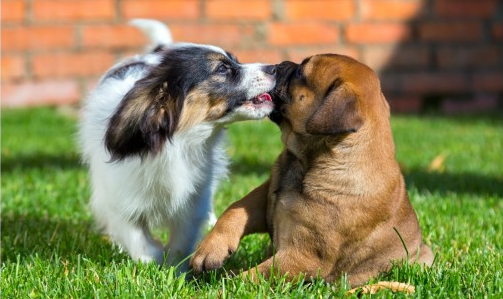Puppy Playtime!
It’s healthy & important, but there are things to watch for to keep it fun for your pup.

Puppies, like children, need to be taught appropriate play skills.
What is cuter than puppies playing? Nothing! It brings a smile to the face to watch a bunch of furballs jumping around, mock fighting, and having fun. That is until one puppy is not having a good time. Luckily, in most cases, no harm, no foul and they quickly resume the fun. But what about when the puppy who got scared goes and hides. Should you push him back to play or let him be? It’s important to support your puppy’s emotional needs. When he is ready he will return, and if he is not, let him participate in his own good time. When we allow puppies to build their trust, their confidence will grow.
Play is important, especially in early puppyhood. Puppies are the most emotionally flexible until the age of 16 weeks, and the good experiences your puppy has now will help him grow up feeling safe and empowered. This is a critical socialization period . After that it gets harder, it takes longer, and your dog may never fully get the hang of feeling comfortable in the world and around other dogs (and other experiences).
My veterinarian/breeder said to wait until my puppy has all of his shots
Early puppyhood is a critical time for socialization and learning. This time will set the stage for the rest of your puppy’s life. This is truly a once-in-a-lifetime chance to show your puppy how to confidently relate to other puppies, unfamiliar people, and strange sights, sounds, and events. It is crucial that this developmental stage is used wisely! Luckily, the vast majority of modern veterinarians and breeders understand that puppies don’t just have medical needs, but behavioral needs as well and will instruct you to begin a properly run puppy training and socialization class as early as possible. Correct puppy socialization can be thought of as a behavioral vaccination.
Here are some resources for you:
The benefits of play in puppies can’t be over emphasized.
- Physical and mental exercise
- Socialization
- Teaching boundaries and rules
- Emotional control
- Bite inhibition- puppies with little or no bite inhibition tend to bite more vigorously and harder than normal. If they don’t learn it as puppies, their bite as an adult will inflict much more serious damage.
- Teaching new skills
What is a Consent Test?

Is the dog on the bottom having fun? Do a consent test to find out. Gently pull off the top pup; if the other puppy comes back for more, release for more play.
Sometimes a puppy in a group has a particularly aggressive play style and does not understand how to play appropriately. Most of the other puppies run from this over assertive puppy. Or this puppy always appears to be pinning another dog beneath it. It is necessary to intervene early with these puppies who are either over aroused or just have poor play skills. Make their play sessions brief, pair them with an adult with good play skills, redirect to toys, and teach an on-off (arouse/settle) switch. To see if one puppy is truly bullying another, use the “consent test”. Hold the tough guy briefly away from the other pup. If the other puppy comes back at the more assertive dog to continue the play, then it is safe to let them play again and it should not be considered bullying. If the other puppy runs off or hides, then he or she was probably not enjoying the encounter, or the top dog had a play style that was too assertive for the bottom dog.
Using play as a training reward
Puppy (and dog!) play is valuable and can be used in training as a reward, but it is important not to allow the release of the puppy back to play until he or she is calm and less aroused. Insist upon fair play to prevent play from escalating to high arousal and then aggression. Be sure that there are frequent pauses in play to avoid over arousal; know when to allow them to work it out and when not. Bites should be inhibited and directed to the legs and lower body, with short mouthing to the neck and head area. Batting, brief pounces and pauses are all parts of good play. We suggest interrupting puppy play every minute or less to briefly get your puppy’s attention back to you for brief moments. At these times, expect your puppy to focus on you and follow simple cues such as sit or down; be sure to reinforce your wonderful pup with high value treats. Then again reinforce your puppy’s calm, attentive behavior by releasing back to play. This also teaches them that coming to you from play does not mean it’s over. (If play ends each time you call your puppy, you will find your puppy not wanting to come to you.!)
Gotcha!

This dog is leaning away from the hand that is reaching for him. He is showing additional signs of stress including the raised paw, ears pulled back, and the furrowed brow. He needs lots of positive gotchas!
Teach your puppy a collar grab (aka, gotcha). Simply start by touching the collar with one hand and then giving your puppy a treat with the other. Work up to gently grabbing the collar, and while still holding it, deliver the treat. Your hand should remain on the collar as you give the treat, then release and repeat a few times. (If your pup is really shying away from the hand, back off on the intensity and nearness of the grab until your dog shows no reaction or is actually happy to see the hand nearing him.) Do several sessions throughout the day, choosing different locations within the house or yard. Do 10-15 collar grabs per session, breaking it up into several collar grabs (always with reward), then play, then several more. It’s great to add in a collar grab when you call your dog to you. Call, gently grab, reward. Once your puppy is happy with your hand coming at his collar, you can use the collar grab to help you call him out of play. Teach your puppy to willingly come toward you when his collar is held; don’t pull or yank him.
Know when to interrupt dog play
There are specific signs that indicate that play between dogs should be interrupted, including:
- Dog is showing signs of distress;
- Excessive mounting and other challenges; however you should not get too excited over the mounting behavior, it’s just that sometimes other dogs don’t like it. Mounting can indicate anxiety or over stimulation;
- Excessive vertical play;
- Excessive vocalization including throaty growls (most good play is actually pretty quiet);
- No interruptions or pauses in play (leading to high arousal);
- When one dog is avoiding the situation; watch for head or body turned away from the other dog;
- When competing for a resource such as a toy or treat;
- Pinning;
- Tandem sneezing (which indicates stress);
- Continued orientation to the other dog’s neck or throat;
- Body slamming or other hard physical contact;
- Grabbing/biting with head shaking;
- Full mouth biting;
- Hackles are raised (piloerection);
- Snarling;
- When the body language of a dog shows that he or she is afraid, including ears back, mouth closed, tail down or tucked, lip licking, and trying to get away. Intervene immediately.
In this video taken at a puppy socialization class there are some nice examples of play. The yellow lab/great Pyrenees mix, Riley, is inviting play using play bows (front feet down and hind end in the air). Harley, the Akita, has nice soft body language in response. In the other puppy play group, you can see that Cody, the yellow lab pup, is unsure of the interactions and comes in for a quick sniff before retreating. He also does a lip lick, which is often a sign of stress, or an appeasement signal (“I mean you no harm”). The instructor is giving frequent breaks from play and having the pet parents do collar grabs before releasing back to play. This was in the first class. In future classes the puppies will be asked to give attention or respond to puppy-level obedience cues before being reinforced with more play.
What about dog parks?
Choose your puppy’s play group carefully to set your puppy up for success. If you do not know the play style of the other dog(s), proceed with caution. I do not recommend taking a puppy to a dog park (that’s an entire blog post in itself!). That can be a recipe for disaster. One traumatic event with an adult dog with poor socialization skills can convince your puppy that other dog are unsafe and not to be trusted. This can potentially set your dog’s emotional development into a tailspin that is not easily changed. But once you have found some perfect playmates, or a good, well-run group, enjoy the fun!

